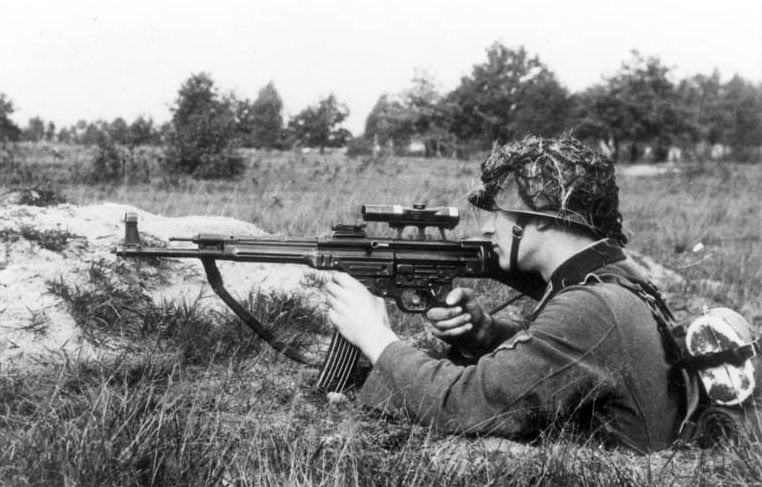During World War I, German engineer Hugo Schmeisser concluded that 7.92mm rifles were too awkward for storming trenches and therefore developed a compact automatic weapon using pistol-caliber rounds that sacrificed long-range accuracy for small size, light weight and reduced recoil.
Entering production in 1917 as the Bergmann Maschinenpistol MP 18, the firearm weighed nine pounds and had an awkward side-mounted snail-drum magazine, but it was popular among the storm troopers specially trained to seize enemy trenches.
In 1934 the Heereswaffenamt (army ordnance bureau) began developing a mid-range cartridge with a shortened case and reduced powder charge, still capable of an effective range of 400 meters. In 1938 the Amt issued a contract to the C.G. Haenel Waffenfrabrik to develop a machine carbine for the resulting “7.92x33mm Infanterie Kurz Patrone,” or short cartridge, capable of serving as both a submachine gun and as a squad automatic rifle and making maximum use of stamped metal parts to simplify manufacture.
Haenel’s chief design engineer—none other than Hugo Schmeisser—took on the challenge by setting the barrel and stock in a straight line to reduce recoil shock, with a pistol grip for the trigger hand and setting the sights—a V sight aft and a hooded sight up front—higher than usual above the barrel. Gas action drove the piston that actuated the bolt and the gun was all metal save for the butt stock.
By 1940 Schmeisser had his essentials down, but numerous technical problems lay ahead of its acceptance. The Haenel plant could handle the small degree of machining necessary, but it lacked the stamping tools, so those were subcontracted out to other companies, such as ERMA and Merzwerke, who in the process redesigned some of the parts.
Read More: This was America’s last true ‘battle rifle’
Read More: This was the (other) famous Vietnam-era rifle
Read More: Delta’s favorite rifle from the battle of ‘The Mog’
Although arrangements were in place in 1941 for the subcontractors, with Haenel doing the final assembly, tooling up for production went slowly and the first 50 prototypes were not ready until July 1942. By then, Carl Walther had learned of the weapon’s development and entered the nonexistent competition with a design of his own, two of which were available by July 1942.
Among the first examples of Haenel’s Maschine Karbine MKb 42s were airdropped to German troops isolated in Cholm, Russia, where they performed exceptionally well. News of this, however, only drew in more competing proposals from more firearms firms such as Mauser, Steyer and ERMA, which further slowed the production process.
Moreover, when Adolf Hitler was briefed on the project in March 1943, he favored canceling it because of the added strain that the kurz round would place on production committed to standard 7.9mm rifle rounds, already stockpiled in the millions. In spite of the Mkb 42’s popularity, Haenel had only produced 8,000 by then.
At that point the Heereswaffenamt found a way around Hitler’s objections by redesignating the weapon as a “machine pistol” and proceeding with production as the Maschine Pistole 43. By the time Hitler learned of the subterfuge, the amount of positive reports from the Eastern Front convinced him to leave MP 43 production be.
A more adaptable variant, the MP 43/1, could be fitted with a grenade launcher and/or optical sights.
In 1944 a development of the MP 43 appeared with more stamped parts to accelerate production. Still later the MP 44 underwent a name change just for propaganda reasons (possibly coined by Hitler himself) as the Sturmgewehr (assault rifle) 44.
In this case, however, the term was appropriate, since the StG 44 offered the options of serving as a submachine gun for assault troops or as a reasonably accurate single-shot rifle at ranges from 50 to 200 yards. Another welcome feature was the ease with which it could field stripped into six parts, the upper and lower receivers being connected by a hinge aft of the magazine well.
A gas-operated, lock breach, tilting bolt weapon capable of selective fire between single shot and fully automatic, the StG 44 was about 37 inches long with a barrel length of 16.5 inches. Empty weight was a rather hefty 10.19 pounds, totaling 11.06 pounds with a 30-round curved magazine in place.
More often the weapon’s users preferred to limit things to 25 rounds per magazine to avoid the possibility of jamming. Rate of fire was 500 rounds per minute at 2,250 feet per second, with a maximum effective range of 600 meters.
As the war turned irretrievably against the Germans, an unusual accessory appeared in the form of the Krummlauf, a carefully curved barrel with associated sights that would allow the StG 44 to fire around corners, a concept whose practicality is still a subject for debate.
With its long-delayed production at full flood by 1945, a final total of 425,977 assault rifles were made, but against the forces arrayed against it, even that impressive figure could not prevent the StG 44 from ending up yet another case of too little, too late to save the Third Reich from its demise in May 1945.
In retrospect the StG 44 was a concept ahead of its time—and one that had a profound effect on the Allied soldiers who encountered it.
After the war the United States military sought a similarly versatile firearm of its own, starting an evolutionary process that led to the M16 assault rifle and its shorter cousin, the M4 carbine. The Soviet Union likewise sought a weapon to perform the tasks of both its 1891-vintage Mosin-Nagant rifle and its PPSh-41 submachine gun.
That led to the development of the 7.62x39 M43 round and a simpler, more durable assault rifle by Mikhail Kalashnikov that entered Soviet service in 1948 as the Avtomat Kalashnikova 47—destined to be the most produced and widely utilized firearm in history.





